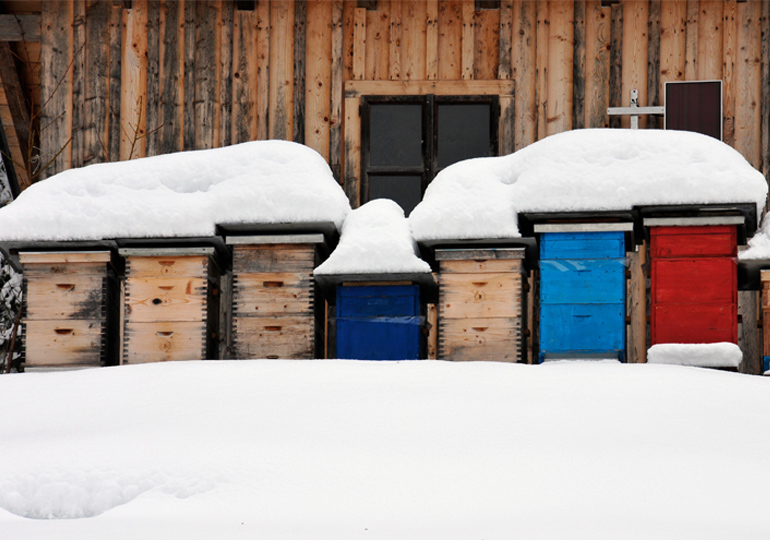Unlike wild bees, the colonies in our hives don’t hibernate. They gather together inside the hive, forming a cluster of bees, and concentrate their reserves and energy in order to maintain the colony’s temperature.
The winter months can be hard. Low temperatures, confinement and a lack of nectar and pollen resource can lead to high winter mortality rates. Varroa-weakened colonies will also have a hard time overwintering, or bouncing back once the weather gets better.
Our team has put together this brief guide of the major questions you should ask yourself when preparing your hives for winter.

The honey harvest deprives the bees of a part of their reserves. Bees need these food reserves to last until spring, and in particular to ensure that the colony recovers properly. Spring consumption (between March and April) can exceed winter consumption, and reserves can rapidly dwindle when the beekeeping season resumes. It is therefore important to closely monitor the hives’ weight at the end of the winter. Between late September and early May, colonies generally need between 15 and 25kg (33 to 55lbs) of winter provisions, and one or two frames of pollen.
Syrup-based nutrition is recommended for regions and periods in which temperatures do not drop below 15°C (59°F) during the day. Following the harvest, a light syrup can be provided as a supplement, in small, regular doses, to stimulate egg-laying and ensure that the bee clusters are large enough to survive the winter. A heavier syrup can then be provided during the winter to supplement reserves and possibly reduce the probability egg-laying.
In colder regions, beekeepers opt for sugar patties (candy) during the winter. Sugar patties have the special property of reducing moisture condensation inside the hive. The moisture causes the sugar patty to dissolve, which makes it possible for the bees to consume it. Lowering the humidity level also reduces the likelihood of mold and pathogen development, which can be harmful to the bees’ intestinal balance (risk of nosema).
In addition, when temperatures lower, the bees stop leaving the hive to look for food. Sugar patties can be placed directly on the frames, with the feeder upside down, enabling the bees to stay inside the hive.
Bees also need protein, which is provided in the best-case scenario by pollen reserves. Pollen is essential for the colony’s vitality: it enables beekeepers to obtain good-sized clusters of bees for wintering and gives the bees enough energy to keep the cluster warm over the winter. To make up for mid-season shortages, it can be useful to provide protein supplements in the fall. Beekeepers can easily make a “protein patty” to serve this purpose.
Food supplements can help strengthen the colonies just before winter. They should be viewed as “insurance” in case the quality of the reserves is insufficient. In good years, you won’t notice a difference… but in bad years, they can serve as a crutch to help your colonies live through the winter.
We recommend (as do others!) that you begin treating your hives against varroa as soon as the harvest is over in order to prevent the harmful effects of varroa when the winter bees emerge (during the fall).
Post-harvest treatment is the most important of the year. It must therefore be very effective, while remaining as safe for the bees, the beekeeper and the honey consumer as possible. To verify the effectiveness of the treatment and measure the level of infestation, beekeepers must carry out at least two follow-up visits during this period – before and after the treatment at the end of the beekeeping season. You can thereby rapidly identify if your treatment was not effective enough, or if the infestation level was too high at the start of the treatment. In that case, you may need to administer a winter treatment (oxalic acid) to reduce varroa pressure and ensure your colonies start off on the right foot in the spring.
For the fastest, most accurate estimate possible, you can count on Varroa EasyCheck to monitor your infestation levels.
Like our homes, hives need to be well-ventilated both in summer and in winter. A lack of ventilation generates a damp cold, which can compromise the colony’s health (by favouring the development of pathogens that cause digestive issues). When winter approaches, the bees themselves seal unwanted openings with propolis. The colony, acting as a cluster, then maintains the hive at a constant temperature of 20°C, thanks to the bees’ movements. But bees don’t only generate heat: they also breathe, producing moisture that must escape. If the hive is too well-sealed, the moisture cannot get out. The condensation on the hive cover attests to this. In some climates, it is necessary to wrap the hives for the winter, with specially designed covers, but these covers are not necessary for milder winters. In all cases, a ventilation opening should be left, even if the temperature drops below -20°C (-4°F).
In addition to good ventilation, it may be necessary to protect the hive with mice prevention measures: entrance reducers or deterrent blades at the entrance to the hive.
In winter, beekeepers must open their hives as infrequently as possible in order to avoid exposing the bees to bad weather. With less frequent visits, it is difficult to rapidly spot warning signs. Bees can be lacking in food stores, be overcome by a major varroa infestation (even after the fall treatment), be poorly ventilated… these are the signs of a colony at risk, requiring urgent corrective action.
To enable you to be directly notified in the event of an anomaly, your hives can be equipped with connected sensors that constantly measure the temperature and humidity level inside the hive. You can thereby be warned immediately if a hive is suffering and needs assistance, without even needing to open it. You can then rapidly take measures to save it.